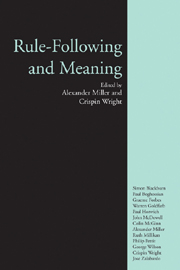Book contents
- Frontmatter
- Contents
- Acknowledgements
- The Contributors
- 1 Introduction
- 2 Skepticism and Semantic Knowledge
- 3 The Individual Strikes Back
- 4 Wittgenstein on Following a Rule
- 5 Wittgenstein, Kripke and Non-Reductionism about Meaning
- 6 Kripke on Wittgenstein on Rules
- 7 Critical Notice of Colin McGinn's Wittgenstein on Meaning
- 8 Meaning and Intention as Judgement Dependent
- 9 The Rule-Following Considerations
- 10 The Reality of Rule-Following
- 11 Truth Rules, Hoverflies, and the Kripke–Wittgenstein Paradox
- 12 Kripke on Wittgenstein on Normativity
- 13 Meaning, Use and Truth
- 14 Kripke's Normativity Argument
- Guide to Further Reading
- Index
5 - Wittgenstein, Kripke and Non-Reductionism about Meaning
- Frontmatter
- Contents
- Acknowledgements
- The Contributors
- 1 Introduction
- 2 Skepticism and Semantic Knowledge
- 3 The Individual Strikes Back
- 4 Wittgenstein on Following a Rule
- 5 Wittgenstein, Kripke and Non-Reductionism about Meaning
- 6 Kripke on Wittgenstein on Rules
- 7 Critical Notice of Colin McGinn's Wittgenstein on Meaning
- 8 Meaning and Intention as Judgement Dependent
- 9 The Rule-Following Considerations
- 10 The Reality of Rule-Following
- 11 Truth Rules, Hoverflies, and the Kripke–Wittgenstein Paradox
- 12 Kripke on Wittgenstein on Normativity
- 13 Meaning, Use and Truth
- 14 Kripke's Normativity Argument
- Guide to Further Reading
- Index
Summary
What is very striking about Kripke's skeptic is an assumption he makes which, once it is brought to light, ought to make us suspicious of his whole way of proceeding; this assumption both is essential to the argument and is itself unargued for. I mean the assumption that if there are semantic facts they will have to be reducible to facts specified non-semantically: for the skeptic is in effect demanding an answer to the question ‘what does meaning/reference consist in?’ which does not just help itself to the notions of meaning and reference. Thus the candidate answers Kripke considers all attempt to say what constitutes a given semantic fact without simply using semantic concepts directly (or indeed indirectly) – viz. actual application, states of consciousness, dispositions to use. The kind of reply that is being implicitly judged illicit is one that simply uses semantic concepts, as follows: what it consists in to mean/refer to addition by ‘+’ is for the speaker to mean/refer to addition by ‘+’ – this is the sort of ‘fact’ that meaning consists in. Remember that Kripke's skeptic is out to show that semantic discourse is not fact-stating; then his implicit assumption is that semantic discourse cannot be regarded as factstating just as it stands. The skeptic is assuming that unless semantic facts can be captured in non-semantic terms they are not really facts; but why should this assumption be thought compulsory? So the question for Kripke is why we cannot give the truth conditions of ‘he means addition by “+”’ simply by re-using that sentence, frankly admitting that no other specification of truth conditions is available – precisely because semantic statements cannot be reduced to non-semantic ones.
- Type
- Chapter
- Information
- Rule-Following and Meaning , pp. 81 - 91Publisher: Acumen PublishingPrint publication year: 2002
- 1
- Cited by



